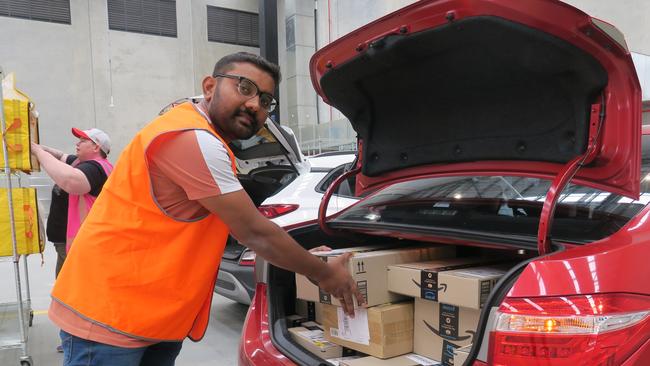Amazon stakes claim for Australia Post’s ‘last mile’ delivery
Australia Post has traditionally held the monopoly on the nation’s last mile delivery. But Amazon is challenging that position.

E-commerce behemoth Amazon has solved one of the biggest problems facing Australian online retailers ahead of the busy Christmas season: “last mile” delivery.
“Last mile” is a domain Australia Post has traditionally had a monopoly on, with a relatively small population scattered over a huge landmass protecting its market share of more than 80 per cent. But Amazon is muscling in, tapping into the gig economy to ensure customers not only get their parcels fast but also in the evenings and on weekends.
While Amazon has contracted delivery to Australia Post and other third-party couriers, it has been steadily building its own network since it launched in Australia six years ago.
It can now service about 80 per cent of the population by road within 12 hours from its fulfilment centre in Sydney. But, via its flex program, it can deliver to even more people.

Amazon Asia-Pacific operations director Akhil Saxena is reluctant to say the e-commerce titan – which has a market capitalisation of $US1.36 trillion ($2.15 trillion), making it the world’s fifth-biggest company by value – is using the gig economy.
Instead, he says, Amazon is providing workers with more convenience.
“I wouldn’t say gig economy. I mean one could argue that it’s gig. But what I think we are providing is more than that. What we are providing is convenience,” Mr Saxena told The Australian during a visit to Amazon’s global headquarters in Seattle.
“If you want to work for only two hours, you choose to work for only two hours. If you want to work for four hours, you work four, if you want to work 12 – you work 12 in a week. You choose the days of the week that you want to work and you get paid for those.”
The gig economy has been marred by safety breaches, including the death of a food delivery worker, aged in his 20s, in Campbelltown in August – the second that month and the 13th since gig work services first took off in 2017.
It has prompted a major industrial relations shake-up trumpeted by the federal government as a solution to improve employee entitlements and safety. The proposed reforms, announced by Employment and Workplace Relations Minister Tony Burke in August, have faced pushback from industry leaders despite receiving support from the unions.
But Mr Saxena said Amazon had a different model to the food delivery companies that have dabbled in parcels – and even existing courier companies in which contractors are often paid by volume of packages they deliver, not by the hours they work, leading to issues such as the dreaded “sorry we missed you” cards or, at worst, potential safety breaches. This is because the more parcels they deliver, the more they earn.

“It’s not like they are being paid per package per hour, it’s for a block of hours that you sign up for,” Mr Saxena said about Amazon’s flex program.
“So what that allows is more flexibility and reliability to say ‘what am I earning?’, and doing it in a manner which is safe. Because what we want to do is say whoever works for Amazon – whether it’s in the transportation network or in a fulfilment network – we do it in the safest way.
“What’s the best way to do that? So our algorithms basically determine how many packages need to go out to the route, per route.”
Amazon has been on a hiring spree, recruiting more than 1000 seasonal workers ahead of the Christmas peak to cope with the influx of parcel deliveries. The company has been completing its recruitment in small batches, which Mr Saxena said allowed for better training.
“We staggered them in hiring because we wanted to provide them better training – especially on safety and how to do the job – and therefore we would not get all these 1000 people in one shot on one day and say ‘OK, please come and start with the job’.
“We can give them the safety information that is required to do the jobs effectively and safely, and do this in small batches so that people have time to ramp up.”
People who sign up to the flex program can earn a minimum of $114 for four hours’ work, delivering via a sedan. If they are driving a cargo van, they can earn at least $270 for eight hours’ work, which includes an unpaid 30-minute break.
Jared Lynch travelled to Seattle as a guest of Amazon




To join the conversation, please log in. Don't have an account? Register
Join the conversation, you are commenting as Logout